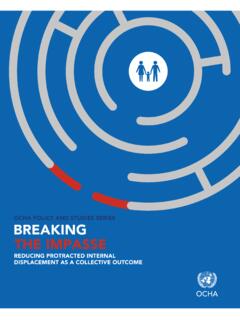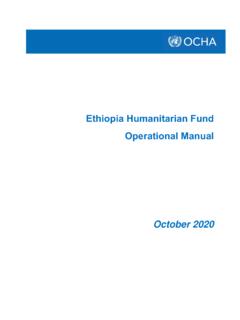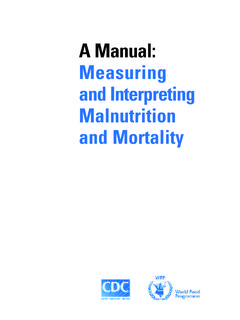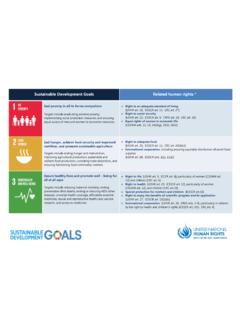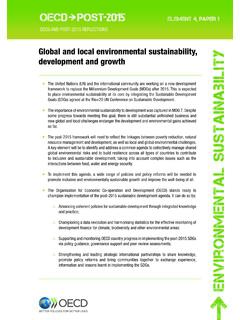Transcription of HUMAN SECURITY IN THEORY AND PRACTICE
1 HUMAN SECURITY IN THEORY AND PRACTICE . Application of the HUMAN SECURITY Concept and the United Nations Trust Fund for HUMAN SECURITY HUMAN SECURITY Unit Office for the Coordination of Humanitarian Affairs United Nations Executive Summary Prepared as a guide for practitioners who wish to integrate the added value of the HUMAN SECURITY approach into their work, this handbook provides an overview of the HUMAN SECURITY concept and its operational impact. Useful tools for applying the HUMAN SECURITY concept, including a step-by- step strategy for developing, implementing and evaluating HUMAN SECURITY programme/projects are provided. Two detailed case studies; one in post-conflict situations and another related to food insecure scenarios, demonstrate the application of these HUMAN SECURITY tools and are followed with additional examples of projects supported under the United Nations Trust Fund for HUMAN SECURITY .
2 This handbook assumes prior knowledge in programme/project management methods, such as Results Based Management (RBM) as well as logical framework analysis, and will be accompanied by a series of trainings for UN agencies, field staff and other stakeholders. 2. TABLE OF CONTENTS. Chapter 1 - The Concept of HUMAN SECURITY and its Added Value The Concept of HUMAN SECURITY as defined by the Commission on HUMAN SECURITY 6. Why HUMAN SECURITY Now? 6. What is HUMAN SECURITY ? 6. What are the main features of HUMAN SECURITY ? 7. What do Protection and Empowerment mean for achieving HUMAN SECURITY ? 8. How does HUMAN SECURITY differ from Traditional SECURITY , HUMAN Development and HUMAN Rights Approaches? 9. The Added Value of HUMAN SECURITY as an Operational Tool 9.
3 Chapter 2 - How to Operationalise the HUMAN SECURITY Concept HUMAN SECURITY Principles and Approach 12. HUMAN SECURITY Programme Phases 13. Phase I: Analysis, Mapping and Planning 13. The HUMAN SECURITY Analytical Framework to Needs/Vulnerability and Capacity Analysis 14. HUMAN SECURITY Strategies 15. The HUMAN SECURITY Multi-Sectorality and Externalities Framework 17. The HUMAN SECURITY Protection and Empowerment Framework 18. Phase II: Implementation 19. Participatory Approaches and Local Capacity Building 19. The Stages of Participatory Implementation 20. Phase III: Impact Assessment 22. The Six Phases of an HUMAN SECURITY Impact Assessment (HSIA) 22. Lessons Learnt, Best Practices, and Mainstreaming of HUMAN SECURITY 25. Chapter 3 - HUMAN SECURITY Case Studies HUMAN SECURITY in Post-Conflict Situations 27.
4 I. Overview of Post-Conflict Scenarios: Characteristics, Gaps and Challenges 27. II. HUMAN SECURITY Principles and Approach in Post-Conflict Situations 30. III. HUMAN SECURITY Programme Phases in Post-Conflict Situations 31. 3. HUMAN SECURITY in Situations of food Insecurity 41. I. Overview of Situations of food Insecurity: Context, Gaps and Challenges 41. II. HUMAN SECURITY Principles and Approach in Situations of food Insecurity 44. III. HUMAN SECURITY Programme Phases in Situations of food Insecurity 46. Annex 1 - Genesis and the Institutional Trajectory of HUMAN SECURITY within the UN. Framework 55. Annex 2 - Sample of Projects funded by the UNTFHS 59. Bibliography 75. 4. List of Acronyms ABHS Advisory Board on HUMAN SECURITY ASEAN Association of South East Asian Nations CFA Comprehensive Framework for Action CHS Commission on HUMAN SECURITY DDC District Development Committees DRC Democratic Republic of the Congo FAO food and Agriculture Organization HDI HUMAN Development Index HLTF High Level Task Force on the Global food SECURITY Crisis HSIA HUMAN SECURITY Impact Analysis HSN HUMAN SECURITY Network HSU HUMAN SECURITY Unit ICC International Criminal Court IDP Internally Displaced Persons ILO International Labor Organization IMF International Monetary Fund IOM International Organization for Migration FHS Friends of HUMAN SECURITY FMLN Farabundo Mart National Liberation Front LAS League of Arab States MDG
5 Millennium Development Goals MONUC United Nations Mission in the Democratic Republic of the Congo NGO Non-Governmental Organization NRS National Referral System OAS Organization of American States OCHA Office for the Coordination of Humanitarian Affairs OHCHR Office of the United Nations High Commissioner for HUMAN Rights OSCE Organization for SECURITY and Co-operation in Europe PAHO Pan-American Health Organization PRSP Poverty Reduction Strategy Paper RFTF Results Focused Transitional Framework SAP Structural Adjustment Programme UN United Nations UNDP United Nations Development Programme UNFPA United Nations Population Fund UNHCR Office of the United Nations High Commissioner for Refugees UNICEF United Nations Children's Fund UNIFEM United Nations Development Fund for Women UNODC United Nations Office on Drugs and Crime UNTFHS United Nations Trust Fund for HUMAN SECURITY UNV United Nations Volunteers WFP World food Programme WHO World Health Organization WTO World Trade Organization 5.
6 Chapter 1 - The Concept of HUMAN SECURITY and its Added Value1. The Concept of HUMAN SECURITY as defined by the Commission on HUMAN SECURITY Why HUMAN SECURITY Now? As argued by the Commission on HUMAN Security2 (CHS), the need for a new paradigm of SECURITY is associated with two sets of dynamics: First, HUMAN SECURITY is needed in response to the complexity and the interrelatedness of both old and new SECURITY threats from chronic and persistent poverty to ethnic violence, HUMAN trafficking, climate change, health pandemics, international terrorism, and sudden economic and financial downturns. Such threats tend to acquire transnational dimensions and move beyond traditional notions of SECURITY that focus on external military aggressions alone.
7 Second, HUMAN SECURITY is required as a comprehensive approach that utilizes the wide range of new opportunities to tackle such threats in an integrated manner. HUMAN SECURITY threats cannot be tackled through conventional mechanisms alone. Instead, they require a new consensus that acknowledges the linkages and the interdependencies between development, HUMAN rights and national SECURITY . What is HUMAN SECURITY ? The CHS, in its final report HUMAN SECURITY Now, defines HUMAN SECURITY as: to protect the vital core of all HUMAN lives in ways that enhance HUMAN freedoms and HUMAN fulfillment. HUMAN SECURITY means protecting fundamental freedoms freedoms that are the essence of life. It means protecting people from critical (severe) and pervasive (widespread) threats and situations.
8 It means using processes that build on people's strengths and aspirations. It means creating political, social, environmental, economic, military and cultural systems that together give people the building blocks of survival, livelihood and dignity. (CHS: 2003: 4). Overall, the definition proposed by the CHS re-conceptualizes SECURITY in a fundamental way by: (i) moving away from traditional, state-centric conceptions of SECURITY that focused primarily on the safety of states from military aggression, to one that concentrates on the SECURITY of the individuals, their protection and empowerment;. 1. This handbook has been developed by the HSU-OCHA under the guidance of Dr. Shahrbanou Tadjbakhsh, Sciences Po, and in close collaboration with Ms.
9 Hitomi Kubo, Sciences Po, and Ms. Elianna Konialis. 2. The Commission on HUMAN SECURITY was established in January 2001 in response to the UN Secretary-General's call at the 2000 Millennium Summit for a world free from want and free from fear. The Commission consisted of twelve prominent international figures, including Mrs. Sadako Ogata (former UN High Commissioner for Refugees). and Professor Amartya Sen (1998 Nobel Economics Prize Laureate). 6. (ii) drawing attention to a multitude of threats that cut across different aspects of HUMAN life and thus highlighting the interface between SECURITY , development and HUMAN rights; and (iii) promoting a new integrated, coordinated and people-centered approach to advancing peace, SECURITY and development within and across nations.
10 What are the main features of HUMAN SECURITY ? HUMAN SECURITY brings together the HUMAN elements' of SECURITY , rights and development. As such, it is an inter-disciplinary concept that displays the following characteristics: people-centered multi-sectoral comprehensive context-specific prevention-oriented As a people-centered concept, HUMAN SECURITY places the individual at the centre of analysis.'. Consequently, it considers a broad range of conditions which threaten survival, livelihood and dignity, and identifies the threshold below which HUMAN life is intolerably threatened. HUMAN SECURITY is also based on a multi-sectoral understanding of insecurities. Therefore, HUMAN SECURITY entails a broadened understanding of threats and includes causes of insecurity relating for instance to economic, food , health, environmental, personal, community and political SECURITY .





